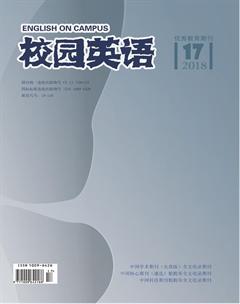在故事教學中提升小學生英語核心素養
【摘要】故事因其豐富的情感,生動的情節,符合學生的思維特征和學習語言的認知特點,故而成為兒童成長的“精神伴侶”。有效的故事教學能夠激發學生閱讀的興趣,能給小學英語課堂注入新的活力。在英語故事教學中,教師應關注故事的發展,培養學生的思維品質;創設故事情境,培養學生學習能力;挖掘故事文本,培養學生的語言能力;延伸故事情節,培養學生文化品格。
【關鍵詞】故事教學;核心素養;思維品質;文化品格
【作者簡介】凌云,江蘇省南通市十里坊小學。
小學生英語核心素養的培養強調關注“人”(學生)的發展,即培養學生的文化品格、學習能力、思維品質、語言能力。如何在課堂教學中逐步落實發展學生核心素養的要求,是當今英語教師需要解決的問題,更是老師們努力的方向。《英語課程標準》(2011年版)在“語言技能”二級目標就英語故事教學做出如下要求:能聽懂簡單的配圖小故事,能在老師的幫助下講述簡單的小故事;能借助圖片讀懂簡單的故事或小短文,能在老師的幫助下表演小故事或小短劇。譯林版英語教材設置了“Story Time ”和“Cartoon Time”板塊,側重于故事過程的描述,強調情節的生動性和連貫性,本文結合故事教學闡述培養學生核心素養的一些思考。
一、關注故事的發展,培養學生的思維品質
心理學研究表明:語言和思維是一對孿生兄弟,思維的發展推動著語言的發展,語言的發展又促進思維的發展。因此,我在教學時,先挖掘詞匯和句子的 “思維訓練點”,然后以故事的形式呈現情景,學生在那種似曾相識的情境中訓練表達,體驗語感,從而獲得思維的發展。教學中教師可設置一些懸念,讓學生在預測、想象中體驗故事學習的快樂。
在教授譯林版小學英語六年級下冊Unit1《The lion and the mouse》時,教師在引入課文前,讓學生預測:What would happen if they met?
A: The lion would eat the mouse, because the mouse was too small and weak.
B: They would play together, because theyre loneliness.
C: The mouse would go away quickly, he was so frightened.
D: The lion was itchy. (癢) The mouse tickled the lion(撓
癢) They could live happily. (眾學生大笑)
……
在這一故事情境中,學生在積極的交流中進行有效的思維,從而將思維與言語發展有效結合起來。
在理解課文時, 文本出現這樣的敘述:The next day, two men caught the lion with a large net. The lion bit the net with his sharp teeth, but that did not help. “How can I get out?”ask the lion sadly.
Lion現在是無助的,它已經用盡全力卻無濟于事,內心的惶恐不安可想而知。為了增加學生的情感體驗,老師將故事拓展開來,讓學生的思緒飛揚。
T: What will the lion say?
A: Ill die here. Who can come and help me?
B: I cant get out of the net. My wife and my children are at home. Theyre hopeless. Oh, my God!
C: The human are hateful! They said they would protect animals, but they caught me, why?
D: I wait for the miracle. Let me wait, wait…
在文本解讀的過程中,筆者創設問題情境,在引導學生思考、推理的過程中,培養學生初步的思維品質,為發展學生的核心素養打下基礎。
二、創設故事情境,培養學生學習能力
《義務教育英語課程標準》指出,語言既是交流的工具,也是思維的工具,是知識、文化和價值觀的載體。學生不僅要在學英語、用英語的過程中使用學習策略,而且還要形成學習英語的能力,故事教學中教師應引導他們積累學習的能力。
在故事教學中創設真實的情景,使學生產生身臨其境的感覺,可把故事中出現的詞匯置身于能聽、能看、可觸摸、可感受的情境中去。仍以譯林版小學英語六年級上冊Unit1《The lion and the mouse》為例,“Please dont eat me. I can help you some day. ”Said the mouse quietly.
“Youre so small and weak, How can you help me?”laughed the lion loudly.
在這個故事中,loudly quietly 是新的詞匯,Said the mouse quietly. laughed the lion loudly. 是新的句型。若采用機械跟讀,不去體味其中的情感,學生的學習熱情得不到鼓舞,那么故事教學就失去了故事味,不能達到預期的效果。執教老師讓學生先揣摩人物的心理,試著讀出句子,然后請出幾組學生練讀,并能做出相應的動作。讓學生自己比較loudly 和quietly的區別,學生在高低錯落的朗讀中體味故事的內涵,脫離了刻板的操練。他們在惟妙惟肖的表演中感受到獨自揣摩和合作學習帶來的快樂,喚起他們與故事人物、情節的情感共鳴。
可見,在培養學生學習能力的過程中,教師要用恰當的方式加以引導,引導他們在嘗試過程中不斷積累英語學習的方法,為他們逐步形成學習能力打下堅實的基礎。
三、挖掘故事文本,培養學生的語言能力
語言能力是一個寬泛的概念,它是英語核心素養中的“核心”,英語教師不僅要教會學生英語語言知識,還要訓練學生的言語技能,在故事教學中進行適度拓展,在實踐中發展英語語言能力。
在整體呈現故事《The lion and the mouse》的基礎上,教師讓孩子進行了一次脫口秀:
A:Hi,Im Mr Lion, Hes Mr mouse. Let me tell you a story about us…
I was in the forest. I was very large and strong. I could jump and caught the small animals. One day, a mouse walked by and woke me up. I was angry and wanted to eat the mouse. “Please dont eat me. I can help you some day. “ the mouse said sadly. I was surprised:“Can he help me? Hes so weak and small. ”
Then I let the mouse go.
The next day, two men caught me with a large net. I bit the net with my sharp teeth, but that did not help. I was so frightened. Just then, the mouse saw me. He made a big hole in the net with his teeth. He was helpful. I got out. I was so happy.
From then on, we helped each other. We became good friends.
通過豐富故事的內容,鮮活的獅子形象展現在學生面前。基于故事學習的語言實踐活動是學生英語語言能力習得的重要途徑。
在學生充分理解故事的基礎上,即課的結尾我設計了這樣一些問題:What does this story tell us?
S: Be helpful.
S: Show your hands when the others need.
S: Being kind to someone is never a waste.
T: The lion is so strong, why couldnt he make a hole in the net?
S:The strongest man has its weakness.
T: The mouse is so small and weak, why did he think he could help the lion?
S: The smallest sometimes has its power!
S: Dont laugh at the small and weak one. .
S: Always believe in who you are!
深入挖掘文本內容,既是對學生思維的訓練,又是對文章內涵的深化。在學生們的表達中,我們看到了他們的語言能力朝著良好的發展態勢邁進。
四、延伸故事情節,培養學生文化品格
文化品格具有較為豐富的內涵,李紅恩2012年在《論英語課程的文化品格》對文化品格做了如下闡述:“文化品格就是指人或事物在價值觀念、思維方式、行為方式等方面所表現出來的精神、氣質、風格、特點和特征。它既是對任何事物的文化屬性的規定,也是其價值取向的重要表征。”文化品格是一種比較上位、抽象的概念,我們只有將它植根于課堂教學中,才能真正體現它的價值,才能使原本抽象的概念煥發出勃勃生命力。
以譯林版英語五年級上冊Unit7 《At weekends》Cartoon Time為例,T: Billy always watches TV at weekends. He always eats a lot too. He becomes fatter and fatter. In autumn, He cant get out.
Billy太胖了,以至于他無法動彈,執教者讓學生仔細觀察插圖,歸納語篇所折射出的文化立場和態度,說出自己的建議。
T: Can you give some suggestions to Billy?
A: Dont eat too much, Billy!
B: Dont always watch TV, Billy!
C: Do some exercise, Billy!
D: Billy, come out and play basketball!
E: Billy, come and play football.
……
T: Can you give an ending for the story?
A: Billy accepts our advice. He usually goes swimming at weekends. He often goes running after school. He sometimes watches films with his brother. Winter comes, hes cool!
B: To keep fit, Billy always goes skating at weekends.
He usually visits her grandparents. He sometimes goes to the park. In winter, hes healthy!
C: Billy is worried. He always gets up early. He usually plays football. He sometimes has a picnic. He does more exercise and eats less. In winter, hes happy!
對故事情節的延伸,既是讓學生對故事內容產生了自己的理解、判斷和評價, 也是檢測學生語言輸出的手段。此教學環節學生知道了運動的重要性,并知道哪些運動使人們身體健康。
由此可見,文化品格的培養對教學提出了更高的要求,讓“培養出怎樣的人”成了落腳點。而這正是核心素養中的“文化品質”的體現。
著名教育家蘇霍姆林斯基強調了在智育中蘊含德育,二者水乳交融,不但要“教書”,也要“育人”的教育理念。在故事教學中教師要充分挖掘文中所蘊含的情感因素,用心挖掘德育細節,達到德育的滲透。
事實證明,有效的故事教學能促進學生的心智發展,為小學生提供自然、有趣的語言習得的氛圍。可見,培養學生的核心素養任重而道遠。因此,故事教學中,教師要真正做一名引導者,讓學生掌握學習策略,讓核心素養的培養落到實處。
參考文獻:
[1]張俐.在故事教學中培養小學生的思維能力[J].中小學英語教學與研究,2017(03).
[2]卓俊靜.英語學科核心素養視角下的文化品格培養[J].文學教育, 2017.
- 校園英語·上旬的其它文章
- Study on the human resource training system of Shangri—La Hotel
- Analysis of the External Environment of Fitness Club
- Love Remains in the Human World
- Struggle between id and superego in The Black Cat
- An Analysis of The Building
- An Analysis of Stevens’s Alienation in The Remains of the Day Under Gaze Theory

